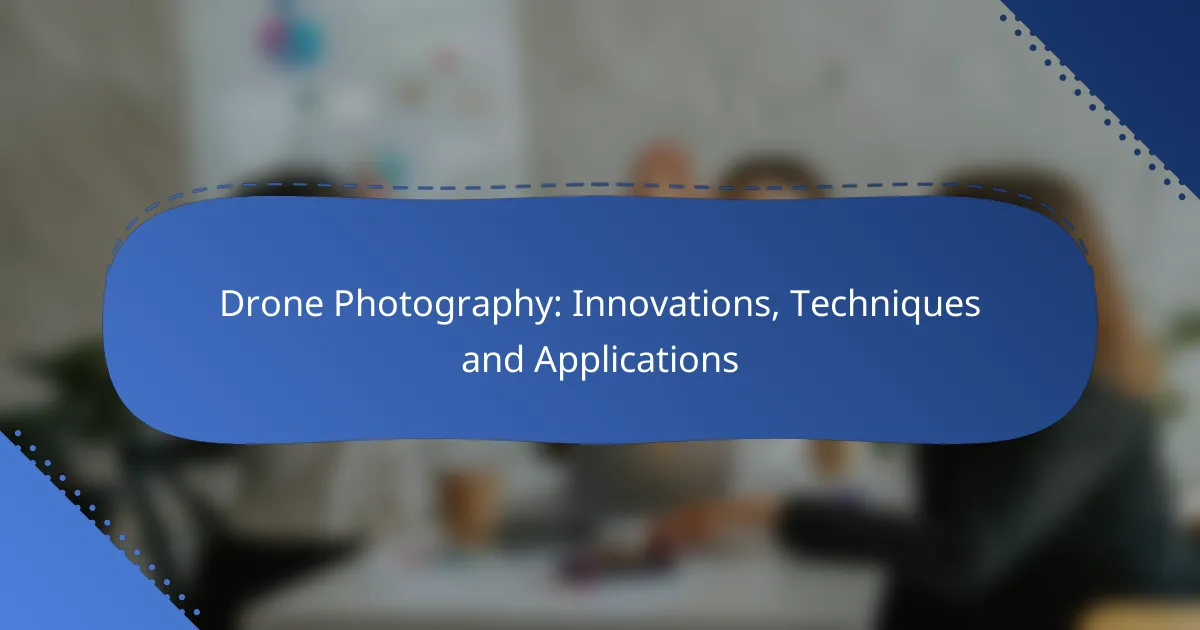Drone photography has rapidly evolved, driven by innovations that enhance image quality and operational efficiency. With advancements such as AI-powered image processing and improved battery life, photographers can capture stunning visuals from unique perspectives. This technology finds diverse applications across industries, from real estate to agriculture, revolutionizing data collection and visual representation.

What are the latest innovations in drone photography?
The latest innovations in drone photography focus on enhancing image quality, operational efficiency, and user experience. Key advancements include AI-powered image processing, real-time data transmission, and improved battery life, all contributing to more effective aerial photography.
AI-powered image processing
AI-powered image processing significantly enhances the quality of photos captured by drones. This technology utilizes algorithms to analyze and optimize images in real-time, improving clarity, color accuracy, and detail. For example, AI can automatically adjust exposure and contrast based on the scene, resulting in professional-grade images without extensive post-editing.
When using drones equipped with AI capabilities, photographers should consider the processing speed and the types of enhancements available. Some systems may offer features like object recognition, which can help in tracking subjects or avoiding obstacles during flight.
Real-time data transmission
Real-time data transmission allows drone operators to receive live feeds from their devices, enhancing situational awareness and decision-making. This innovation is crucial for applications such as surveying, search and rescue, and event coverage, where immediate feedback is essential.
To maximize the benefits of real-time data transmission, ensure that your drone supports high-bandwidth communication protocols. Look for models that offer low-latency streaming to maintain a smooth and responsive user experience, especially in dynamic environments.
Enhanced battery life
Enhanced battery life is a critical innovation in drone photography, enabling longer flight times and more extensive coverage. Many modern drones now feature batteries that can last anywhere from 20 to 40 minutes, depending on the model and conditions.
When selecting a drone, consider the trade-offs between battery life and payload capacity. Heavier cameras may reduce flight time, so it’s essential to balance the equipment you carry with the desired duration of your shoot.
Obstacle avoidance technology
Obstacle avoidance technology is designed to prevent drones from colliding with objects during flight, enhancing safety and operational efficiency. This system uses sensors to detect obstacles and automatically adjusts the drone’s path to avoid them.
For effective use of obstacle avoidance features, familiarize yourself with the specific capabilities of your drone. Some models offer advanced features like 360-degree obstacle detection, which can be particularly useful in complex environments.
High-resolution sensors
High-resolution sensors are essential for capturing detailed aerial images and videos. Many drones now come equipped with sensors that can shoot in 4K or even higher resolutions, allowing for stunning visual content.
When choosing a drone, pay attention to the sensor specifications, including megapixels and dynamic range. Higher resolution sensors can provide more detail, but they may also require more storage space and processing power, so plan accordingly for your projects.
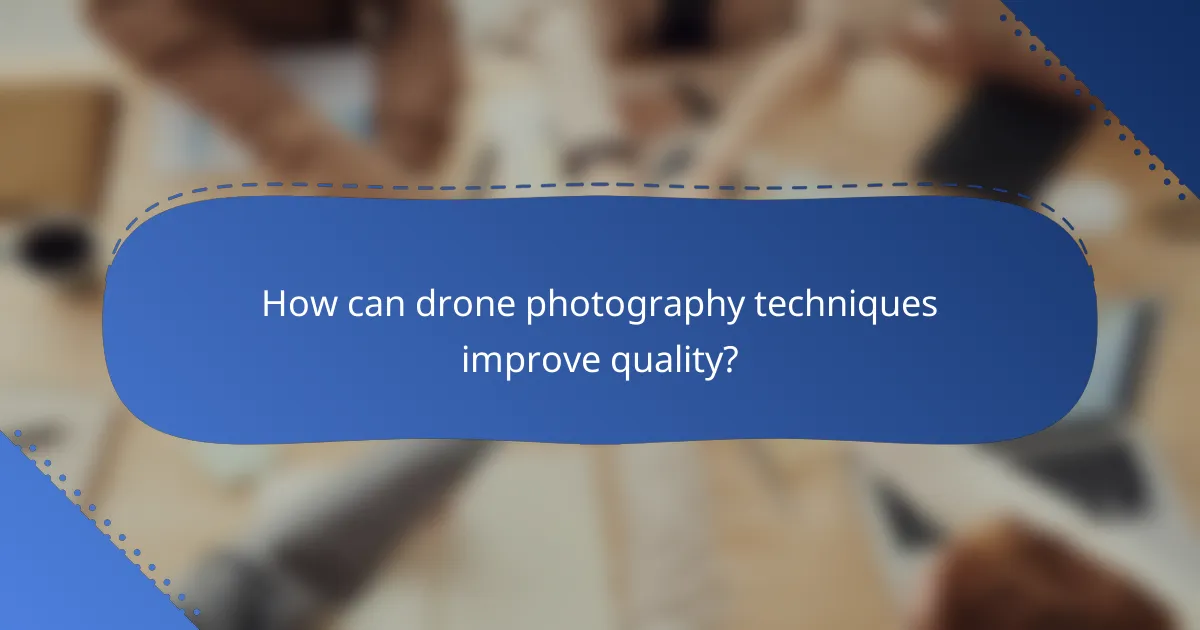
How can drone photography techniques improve quality?
Drone photography techniques can significantly enhance image quality by utilizing advanced imaging methods and creative approaches. By mastering these techniques, photographers can capture stunning visuals that stand out in both professional and personal projects.
Use of HDR imaging
High Dynamic Range (HDR) imaging combines multiple exposures to create a single image with a broader range of light and color. This technique is particularly useful in drone photography, where landscapes often feature bright skies and dark ground elements. To implement HDR, capture at least three images at different exposures and merge them using editing software.
When shooting HDR, ensure your drone is stable to avoid motion blur. Using a tripod or a drone with a gimbal can help maintain consistency between shots. Aim for a balanced exposure range to avoid overexposed highlights or underexposed shadows.
Long exposure techniques
Long exposure techniques in drone photography allow for the capture of motion blur, creating a sense of movement in still images. This is particularly effective for photographing flowing water or busy urban scenes. To achieve this, set your camera to a slow shutter speed, which may require using ND filters to reduce light entering the lens.
When applying long exposure, consider the time of day; early mornings or late afternoons provide softer light. Be cautious of wind conditions, as they can affect stability and image sharpness. A typical exposure time might range from a few seconds to several minutes, depending on the desired effect.
360-degree panoramic shots
360-degree panoramic shots offer a comprehensive view of the surroundings, making them ideal for landscapes and real estate photography. To create these images, fly your drone in a circular path while capturing multiple overlapping photos. Software can then stitch these images together to form a seamless panorama.
Ensure your drone is equipped with a high-resolution camera for the best results. Pay attention to the horizon line and avoid capturing too much sky or ground to maintain balance. A typical overlap of 20-30% between images helps achieve a smooth final product.
Composition rules for aerial shots
Composition rules are crucial for creating visually appealing aerial shots. The rule of thirds is a fundamental guideline; position key elements along the grid lines or at their intersections to draw the viewer’s eye. Additionally, leading lines can guide attention through the image, enhancing depth and interest.
Consider the foreground, middle ground, and background to create layers in your composition. Avoid cluttered scenes; instead, focus on a single subject or theme. Experiment with different angles and altitudes to find the most compelling perspective for your shot.
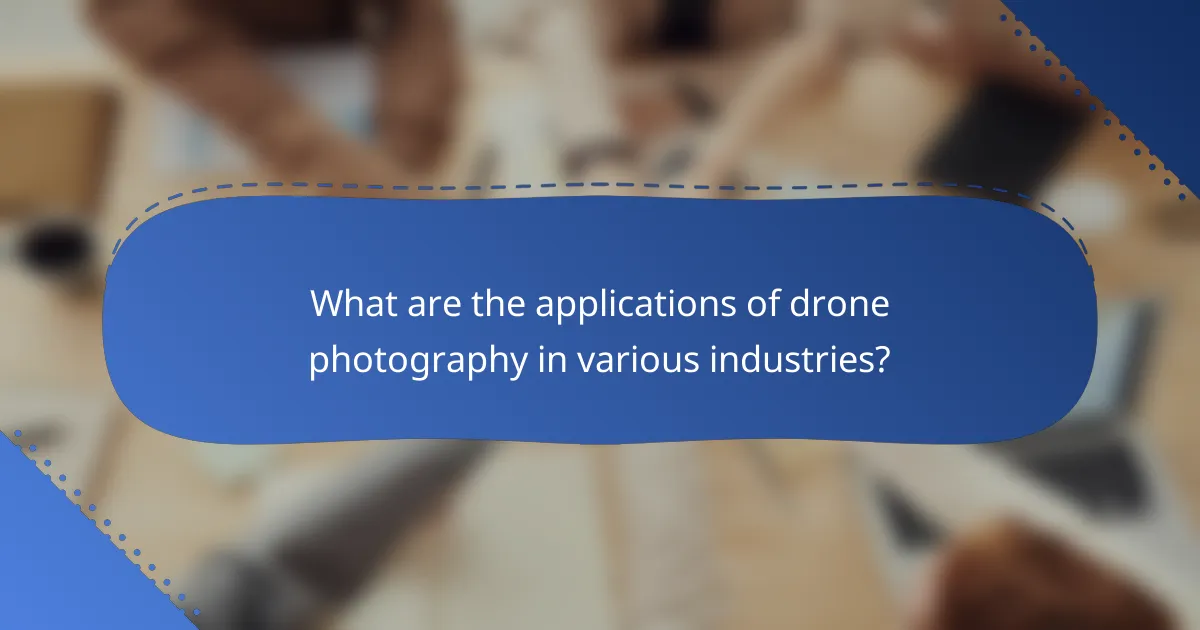
What are the applications of drone photography in various industries?
Drone photography has diverse applications across multiple industries, enhancing efficiency and providing unique perspectives. From real estate to agriculture, drones offer innovative solutions that improve data collection and visual representation.
Real estate marketing
In real estate marketing, drone photography provides stunning aerial views that showcase properties and their surroundings effectively. High-quality images and videos can highlight features such as large yards, nearby amenities, and neighborhood layouts, attracting potential buyers.
Using drones can significantly reduce the time needed for property shoots, allowing agents to capture multiple listings in a single day. Consider investing in a drone with a high-resolution camera to ensure the best quality visuals that stand out in listings.
Event coverage
Drone photography is increasingly popular for event coverage, offering unique aerial perspectives that traditional photography cannot match. Whether it’s weddings, festivals, or corporate events, drones can capture sweeping shots that encapsulate the atmosphere and scale of the occasion.
When using drones for events, ensure compliance with local regulations regarding airspace and privacy. Planning flight paths in advance can help avoid crowded areas and ensure smooth operation during the event.
Agricultural monitoring
Agricultural monitoring through drone photography allows farmers to assess crop health and land conditions efficiently. Drones equipped with multispectral cameras can capture data that reveals plant stress, irrigation needs, and pest infestations.
Farmers can use this information to make informed decisions, potentially increasing yields and reducing costs. Regular drone flights during the growing season can provide timely insights, making it easier to manage large fields effectively.
Construction site inspections
Drone photography is invaluable for construction site inspections, offering real-time aerial views that help monitor progress and ensure safety compliance. Drones can quickly survey large sites and provide updates to stakeholders without the need for extensive ground inspections.
Using drones can save time and reduce labor costs associated with traditional inspection methods. It’s essential to maintain clear communication with the construction team to align drone operations with site activities and safety protocols.
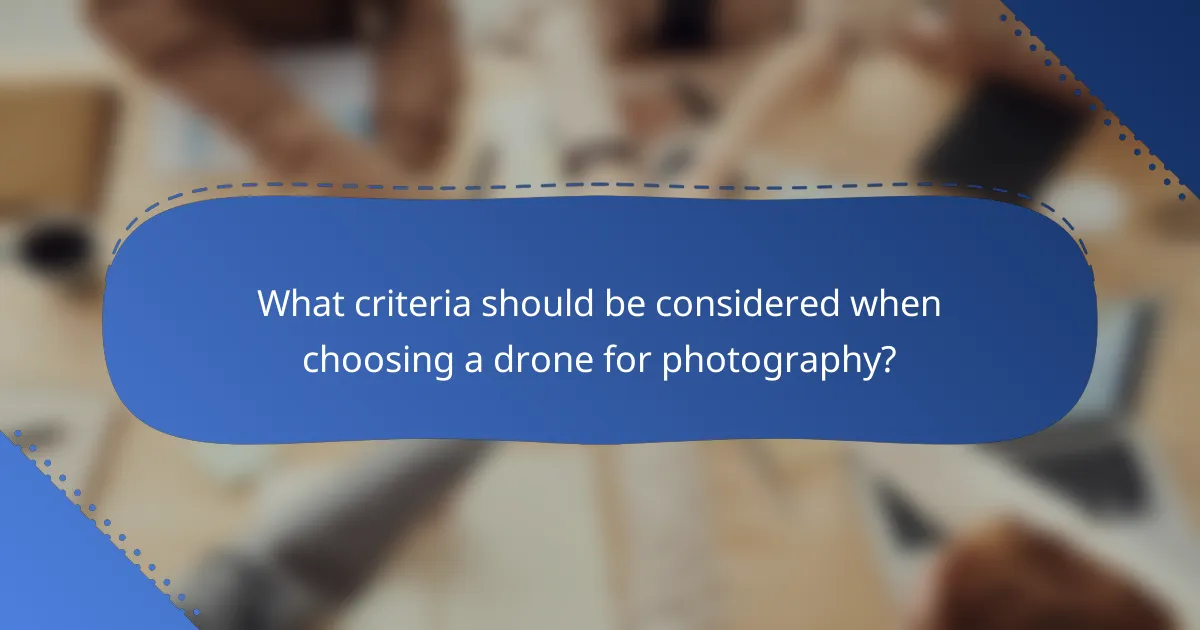
What criteria should be considered when choosing a drone for photography?
When selecting a drone for photography, key criteria include camera quality, flight time, and stability features. These factors significantly impact the overall performance and quality of your aerial images.
Camera quality and resolution
The camera quality is crucial for capturing high-resolution images and videos. Look for drones equipped with at least a 12 MP camera, as this will provide clear and detailed shots. Additionally, consider drones that support 4K video recording for professional-grade footage.
Check for features like adjustable aperture and image stabilization, which can enhance image quality in varying lighting conditions. Drones with larger sensors typically perform better in low light, making them ideal for dusk or dawn photography.
Flight time and range
Flight time is a vital consideration, as it determines how long you can capture images before needing to recharge. Most consumer drones offer flight times ranging from 20 to 30 minutes. Longer flight times allow for more extensive shooting sessions without interruptions.
Range is equally important, as it affects how far you can fly the drone from your control point. Look for drones with a range of at least 1 km for flexibility in capturing diverse landscapes. However, be mindful of local regulations regarding drone flight distances.
Stability and control features
Stability is essential for clear photography, especially in windy conditions. Drones with advanced GPS and altitude hold features provide better stability, allowing for smoother shots. Additionally, consider models with obstacle avoidance systems to prevent crashes during flight.
Control features such as follow-me mode and point-of-interest flight can enhance your shooting experience. These features allow the drone to autonomously track subjects or circle around points of interest, freeing you to focus on composition and framing your shots.
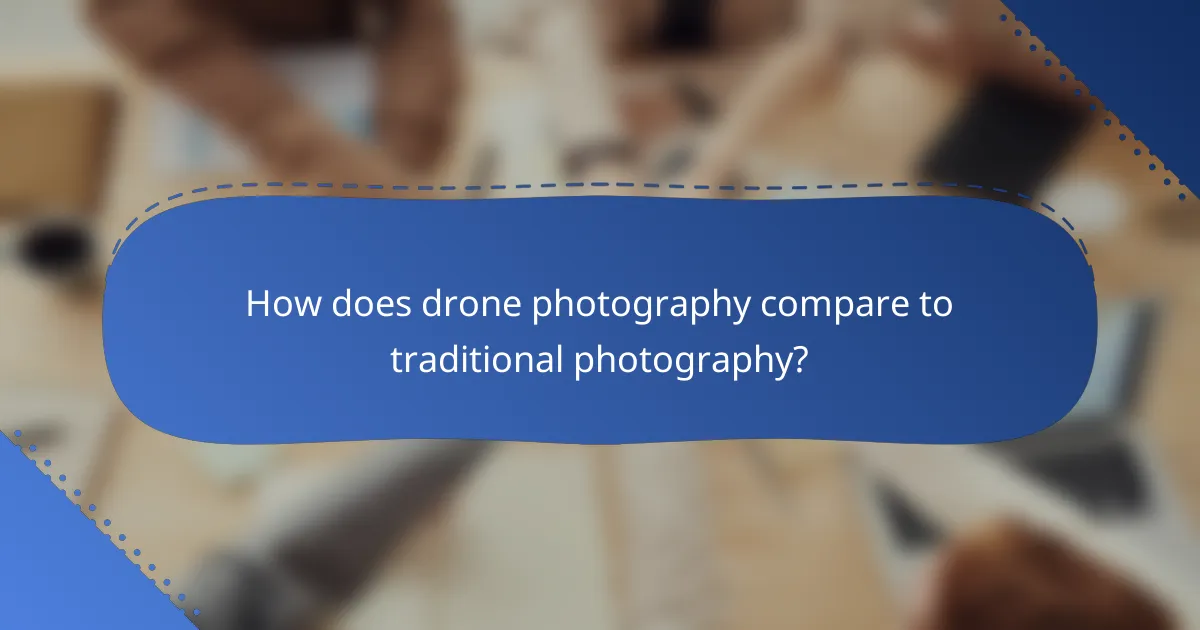
How does drone photography compare to traditional photography?
Drone photography offers distinct advantages over traditional photography, primarily through aerial perspectives and enhanced accessibility. While traditional photography relies on ground-level viewpoints, drones can capture images from heights and angles that were previously difficult or impossible to achieve.
Cost-effectiveness
Drone photography can be more cost-effective than traditional methods, especially for large-scale projects. Hiring a helicopter for aerial shots can be significantly more expensive than using a drone, which often requires only a skilled operator and the drone itself.
Additionally, drones can reduce the need for extensive equipment setups and labor costs associated with traditional photography. For instance, a single drone operator can cover vast areas in a fraction of the time it would take a team on the ground.
Unique perspectives
Drones provide unique perspectives that enhance storytelling in photography. They can capture sweeping landscapes, architectural details, and dynamic action shots from angles that ground-based cameras cannot reach.
This capability allows photographers to create compelling visual narratives, making drone imagery particularly valuable in fields like real estate, tourism, and event coverage. For example, a real estate agent can showcase a property’s surroundings with stunning aerial views that highlight its location and features.
Time efficiency
Drone photography is often more time-efficient than traditional photography methods. Drones can quickly cover large areas, allowing photographers to capture multiple shots in a short period. This speed is particularly beneficial for events or projects with tight deadlines.
Moreover, drones can be deployed rapidly, eliminating the need for extensive setup time associated with traditional equipment. For instance, a drone can be launched and ready to shoot within minutes, making it ideal for capturing fleeting moments or changing conditions.
